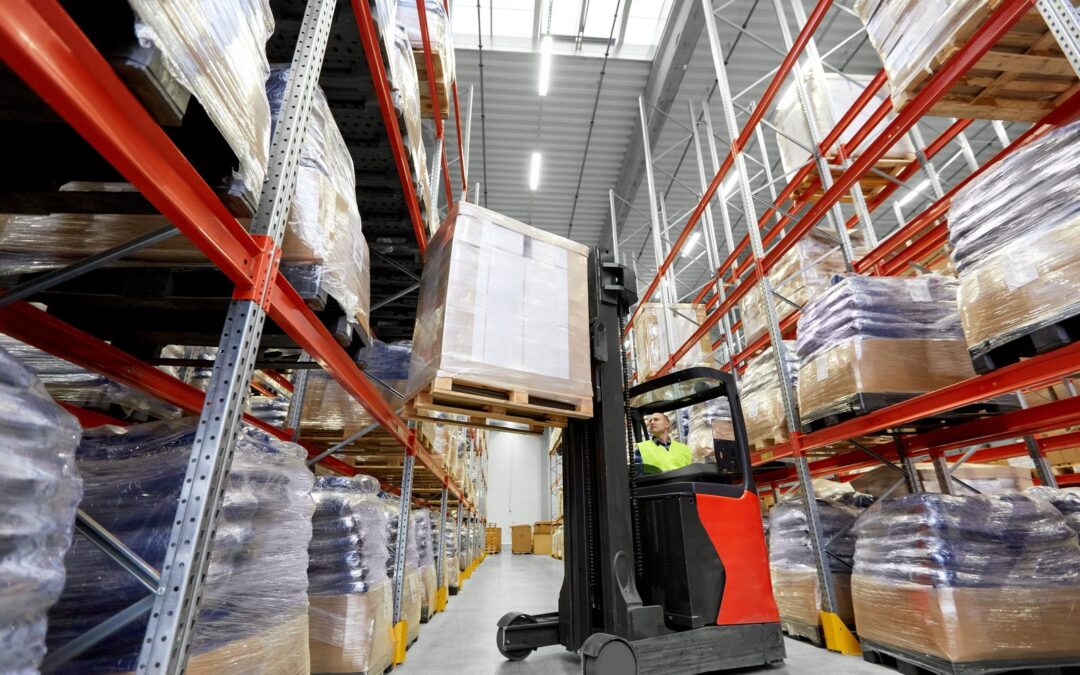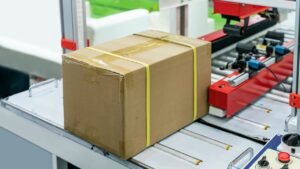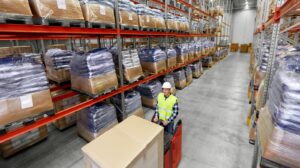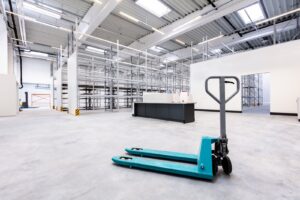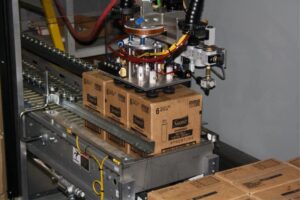Semi-automatic loader packaging systems are designed to improve productivity by automating repetitive tasks while still allowing human oversight where necessary. These machines are widely used in industries such as food and beverage, pharmaceuticals, cosmetics, and consumer goods, where consistent packaging quality is essential. By integrating semi-automatic packaging machines into operations, businesses can enhance their efficiency, reduce errors, and improve overall product presentation.
What is Semi-Automatic Loader Packaging?
A semi-automatic loader packaging system is a type of packaging equipment that combines both manual and automated processes. This system automates certain packaging tasks while still requiring human intervention for specific functions such as loading products, adjusting machine settings, or handling packaging materials. It offers a balance between efficiency and control, making it suitable for various industries.
These machines are commonly used in industries where full automation is not feasible due to variable product sizes, packaging material constraints, or budget limitations. They help improve productivity while allowing flexibility in packaging different products. Semi-automatic loader packaging systems are ideal for businesses looking to enhance efficiency without fully eliminating manual operations.
Unlike fully automatic systems, semi-automatic loaders allow operators to control part of the process while the machine handles repetitive tasks, improving speed and efficiency compared to manual operations.
How Semi-Automatic Loader Packaging Works
The working mechanism of a semi-automatic loader packaging system involves a combination of manual input and machine-assisted operations. Here is a step-by-step breakdown of the process:
- Product Loading:
The operator manually places the product or packaging material onto the loader. This step ensures that each item is correctly positioned for the packaging process. Proper placement helps prevent errors and ensures smooth machine operation. - Positioning and Adjustment:
The machine automatically adjusts the product to align it for packaging. Sensors or guides ensure precise positioning to maintain consistency. Proper alignment reduces errors and enhances packaging efficiency. - Packaging Process Initiation:
The operator starts the machine, initiating the packaging cycle.Depending on the system, the machine may seal, wrap, or fill the product.Automated operations ensure speed, accuracy, and minimal manual effort. - Completion and Discharge:
Once the packaging process is complete, the system discharges the product. The packaged items move to the next stage, such as labeling or shipping. This step ensures a continuous workflow and maximizes productivity. - Operator Supervision:
Operators monitor the machine’s performance throughout the process. They make necessary adjustments and refill packaging materials as needed. Regular supervision helps maintain efficiency and prevent downtime.
Benefits of Semi-Automatic Loader Packaging
- Increased Efficiency
Semi-automatic loaders streamline packaging by automating repetitive tasks, significantly reducing the time required for each packaging cycle. This increased efficiency allows businesses to boost their production capacity without compromising quality. As a result, companies can meet higher demand while maintaining a smooth and consistent workflow. - Cost-Effective Solution
Unlike fully automated packaging systems, semi-automatic loaders provide an affordable yet highly efficient alternative for businesses looking to optimize operations. They enhance productivity while reducing the need for excessive manual labor, leading to cost savings. This makes them a practical investment for businesses aiming to improve efficiency without incurring high automation expenses. - Flexibility in Operations
Semi-automatic loaders are designed to handle a variety of packaging materials and product sizes, making them suitable for diverse industries. Their adaptability ensures seamless integration into existing production lines, catering to different packaging requirements. This flexibility allows businesses to switch between different products without significant modifications or downtime. - Reduced Human Error
By automating critical packaging processes, semi-automatic loaders help minimize errors that often occur with manual handling. Consistent and precise operations ensure uniform packaging quality, reducing the risk of defects or mispackaging. This leads to improved customer satisfaction and fewer product returns due to packaging issues. - Improved Safety
Manual packaging tasks can expose workers to repetitive strain injuries and other workplace hazards, but semi-automatic loaders help mitigate these risks. By reducing physical strain and manual handling, these machines create a safer work environment for employees. This not only enhances worker well-being but also reduces potential liability and compensation costs for businesses.
Industries Using Semi-Automatic Loader Packaging
Several industries rely on semi-automatic loader packaging to streamline their production processes. Some of the most common include:
- Food & Beverage: Enhances packaging efficiency for snacks, drinks, and processed foods, maintaining freshness and quality. It reduces manual labor while increasing production speed. Ensures proper sealing and portion control for consumer convenience.
- Pharmaceuticals: Guarantees precise and safe packaging of medicines, supplements, and medical tools to meet strict industry standards. Helps prevent contamination and ensures accurate labeling. Increases efficiency while complying with regulatory requirements.
- Cosmetics & Personal Care: Streamlines packaging for creams, lotions, perfumes, and beauty products, preserving product integrity. Ensures hygienic and appealing packaging for consumer satisfaction. Reduces waste and improves shelf life.
- Retail & Consumer Goods: Accelerates packaging of electronics, clothing, and household items, optimizing the supply chain. Reduces damage and ensures secure packaging for transport. Increases packaging consistency and speed.
- Industrial & Automotive: Secures packaging for automotive parts, hardware, and industrial components, ensuring durability. Reduces handling risks and enhances protection during transit. Improves efficiency in large-scale production lines.
Factors to Consider for Semi-Automatic Loader Packaging
When selecting a semi-automatic loader for your packaging needs, consider the following factors:
- Type of Packaging Material
The packaging system must be compatible with the materials used, such as plastic film, cartons, bottles, or flexible pouches. Incompatibility can lead to inefficiencies, product damage, or increased material waste. Choosing the right system ensures smooth packaging operations and maintains product quality. - Product Size and Shape
Different products come in various sizes and shapes, so the loader must accommodate them efficiently. A mismatch can cause packaging errors, product misalignment, or machine blockages. Selecting a system that suits your product dimensions ensures consistent and precise packaging. - Production Volume
A packaging system should match your required production output to avoid bottlenecks in operations. If the machine cannot handle your workload, it may slow down production, leading to missed deadlines. Investing in a system with sufficient capacity ensures efficiency and meets demand without delays. - Ease of Operation and Maintenance
A user-friendly system with simple controls and minimal maintenance requirements is essential for smooth operations. Complicated machinery can lead to increased downtime and require skilled operators, raising labor costs. A well-designed loader improves efficiency, reduces errors, and extends machine lifespan. - Cost vs. Return on Investment (ROI)
The initial investment, operational costs, and long-term savings must be carefully analyzed before making a purchase. A cost-effective system should reduce labor expenses, minimize material wastage, and enhance productivity. Choosing the right loader ensures a profitable return on investment over time. - Safety Features
Safety is a critical factor in any packaging system, as it protects workers and prevents machine malfunctions. Features such as emergency stop buttons, sensors, and protective covers can reduce the risk of accidents. Investing in a machine with proper safety measures enhances workplace security and compliance with regulations. - Scalability
Your business needs may expand, requiring a system that can grow with your production demands. A scalable packaging loader allows for future upgrades or integration with other automation equipment. Choosing a flexible system ensures long-term efficiency and prevents the need for frequent replacements.
Types of Semi-Automatic Packaging Machines
There are different types of semi-automatic packaging machines designed for specific applications. Some popular ones include:
1. Cartoners
Cartoners are packaging machines designed to form, fill, and close cartons for various products. These machines are widely used in food, pharmaceutical, and consumer goods industries to package items efficiently. Depending on the operation type, cartoners can be horizontal or vertical, catering to different packaging needs.
2. Case Packers
Case packers are used to automate the process of placing products into cases or boxes for shipping and storage. These machines improve efficiency and consistency while reducing labor costs. They come in different types, such as side-load, top-load, and wrap-around case packers, depending on the packaging requirements.
3. Tray & Carton Formers
Tray and carton formers automate the creation of trays and cartons, providing a structured and efficient way to package goods. These machines ensure uniformity in packaging, which is essential for retail and distribution. They are commonly used in industries like food, beverage, and e-commerce packaging.
4. Tray Packers
Tray packers assist in organizing and packing products into trays for easy handling and transportation. These machines help streamline production lines by reducing manual labor and improving packaging speed. They are ideal for industries that require bulk packaging, such as beverage and dairy products.
5. Palletizers
Palletizers are machines designed to stack products onto pallets for shipping and warehouse storage. They enhance efficiency by automating the palletizing process, reducing human effort and the risk of injury. Available in robotic, inline, and layer palletizers, these machines are essential in logistics and supply chain operations.
6. Case Erectors & Sealers
Case erectors and sealers automate the formation and sealing of shipping cases, ensuring secure packaging for transport. These machines improve efficiency and reduce packaging errors, making them crucial for high-volume industries. They help maintain product integrity while optimizing packing speed.
7. Feeders & Denesters
Feeders and denesters are used to separate and feed trays, containers, or cartons into packaging lines. These machines ensure a smooth and continuous supply of materials, reducing bottlenecks in production. They are particularly useful in food packaging and automated assembly lines.
8. Robotic Systems
Robotic packaging systems integrate advanced automation to enhance precision and speed in packaging operations. These systems can handle tasks such as picking, placing, packing, and palletizing, significantly improving efficiency. They are widely used in industries looking to optimize production with minimal human intervention.
9. Product Accumulators
Product accumulators are machines that temporarily hold products to ensure a smooth flow in production lines. They help prevent congestion and interruptions by regulating product movement before the next packaging stage. These systems are commonly used in bottling, labeling, and conveyor-driven industries.
How to Maintain a Semi-Automatic Loader Packaging System
Proper maintenance ensures the longevity and efficiency of your packaging machine. Follow these best practices:
- Regular Cleaning: Keep the machine free from dust, debris, and product residues to prevent blockages and contamination.
- Lubrication of Moving Parts: Apply lubricant to mechanical components to reduce wear and tear.
- Inspection and Replacement of Worn Parts: Check for signs of wear and replace damaged parts to avoid unexpected breakdowns.
- Calibration and Adjustments: Ensure settings are accurate for consistent packaging quality.
- Operator Training: Train staff on proper operation and maintenance to prevent mishandling.
Conclusion
Semi-automatic loader packaging provides businesses with a practical and cost-effective solution for improving packaging efficiency. By automating repetitive tasks while allowing manual oversight, these systems strike a balance between full automation and manual labor. They enhance productivity, reduce errors, and ensure consistent packaging quality, making them a valuable investment for industries ranging from food and pharmaceuticals to cosmetics and consumer goods.

